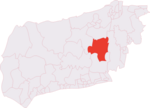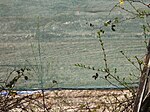Henfield railway station
Henfield was a railway station on the Steyning Line which served the village of Henfield. It was equipped with a siding which received coal to serve the Steam Mill and Gas Works. The station closed as a result of the Beeching Axe in 1966 and now forms part of the Downs Link path. Nothing remains of the station today other than the name "Station Road". A housing estate named "Beechings" occupies much of the station's site, somewhat ironically given that it was British Rail Chairman Richard Beeching whose report recommended closure of the line.Henfield Station was used in the Second World War as the loading point for locally grown sugar beet to be transported North to London, and Betley Bridge where the line crossed the River Adur about a mile to the North was a strategic target for German bombers.
Excerpt from the Wikipedia article Henfield railway station (License: CC BY-SA 3.0, Authors).Henfield railway station
Beechings,
Geographical coordinates (GPS) Address Nearby Places Show on map
Geographical coordinates (GPS)
| Latitude | Longitude |
|---|---|
| N 50.932 ° | E -0.2853 ° |
Address
Beechings 14
BN5 9XB
England, United Kingdom
Open on Google Maps










